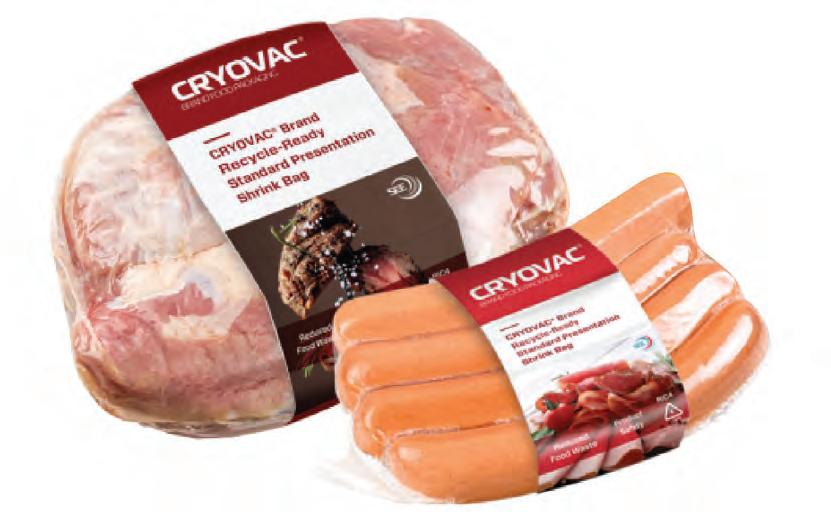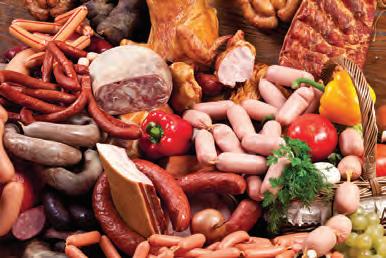
6 minute read
EDUCATION
Getting 2025 ready starts now with Sealed Air’s virtual event
Sealed Air continues to run a series of virtual events designed to educate the food industry on the benefits of overhauling its packaging practices in the face of national packaging targets and changing consumer perceptions. Food and Beverage Industry News reports.
Global packaging specialist Sealed Air continues to offer well researched and insightled virtual events to help stakeholders in the food industry see how they can solve their critical packaging challenges, all the while delivering sustainable outcomes.
During its most recent SEE. SOLVE.SUSTAIN virtual event titled 10 Ways to Design for Packaging Circularity and Appeal to Australia’s Fresh Protein Shoppers, food producers were shown how they can use the 10 sustainable packaging principles to deliver retail solutions that address national sustainable packaging targets, and appeal to consumers’ sentiment for sustainable packaging.
Anna Di Bello, Sealed Air’s fresh red meat marketing director for the Australia, New Zealand, Japan and Korea regions, believes adapting to new packaging targets will have a long-term positive impact for the entire food supply chain.
“The virtual event was an opportunity for food producers to assess their own packaging usage, and understand how they can use the guidelines to help them reach their packaging targets,” said Di Bello.
“In doing so however, it’s important that we don’t lose sight of our global food waste challenges either, and we should avoid aggressively pursuing one target at the expense of the other.
“Rather, it’s about finding the right balance.”
Di Bello highlighted Sealed Air’s ever-evolving range of innovative CRYOVAC brand packaging solutions as a way of demonstrating the company’s capacity to help those within the industry reach packaging targets.
“The consumer is at the core of driving change. We do regular consumer studies and monitor their attitudes towards the key environmental problems,” she said.
“Plastic in oceans, the amount of plastic being used, and the amount of plastic waste, are major concerns globally.”
Then there is the importance of investor confidence in what Sealed Air offers. “When we think about the investor and where they want to put their money, there is a social licence to operate where we need to put our hand up and say ‘yes, we are a responsible company and worthwhile investment opportunity because we are designing for a sustainable business model’,” said Di Bello.
“We need to design sustainable products that don’t just serve the function for today but avoid problems for tomorrow. And it goes deeper than just managing environmental waste.
“The definition of true sustainability is incorporating good environmental outcomes, good social responsibility, like ethical sourcing, and then the economic overlay.” As Di Bello described in the virtual event, packaging design is a science that needs to meet the demands of all of its stakeholders. While Australia’s pursuit to 2025 National Sustainable Packaging targets might seem ambitious, the good news is that food manufacturers and brand owners can start today and make some positive inroads.

The Sealed Air webinars educate companies on ways to create better circularity in packaging.
A range of sustainability targets have been set out, some for 2025 and others as far out as 2030. Di Bello knows those food manufacturers who respond early can maximise the opportunity to drive brand appeal. During the event it was discussed that in a survey of Australian meat consumers, it was found over 48 per cent said they were more likely to purchase meat products they knew were in recyclable packaging, so it makes sense for companies to act as soon as they can.
The virtual event, which targeted fresh protein processors, outlined the 10 sustainable packaging principles and how they can be used to help deliver 2025 sustainable packaging targets, as well as plastics circularity.
“We put forward the 10 Sustainable Packaging principles which Sealed Air aligns with,” said Di Bello.
“This event gave customers and food manufacturers, that may not be up to date with targets or principles, a way to understand them. We showed them how they can bring the principles to life with some practical examples, too.”
“Being able to shift from a
linear economy and create a circular economy for packaging, is an exciting space, which will yield both economic and environmental benefits.
“To date, we have kerbside recyclable and flexibles that can be recycled through store take back programs, but one day they will be capable of being truly circular. We just don’t have the infrastructure for advanced recycling in Australia – yet.”
The switch between business models creates an exciting opportunity for clients.
“The exciting shift for us in the packaging space was moving from a linear business model, in that we designed packaging to be highly efficient to protect products, to also concentrating on a recycling and circular economy,” said Di Bello.
“We have to redesign our packaging to enable that to happen.
“We continue to use plastic resources efficiently and there will be investments made around us, within the industry, to make that happen.”
Sealed Air is developing and designing more recyclable products based on the current recycling technology available, with the aim of ‘future-proofing’ its offering.
“The aim is to design new recycling technologies that enable us to achieve better circularity and of course, all without compromising product protection and shelf life” said Di Bello.
“There will be a transition period where a good job is just avoiding landfill for today, but a better and more sustainable job will be the stage where capturing and reusing the plastic, without having to extract more out of the ground, and also process it more efficiently.”
Efficient design and protection have always underpinned CRYOVAC brand packaging innovations, but there’s been some developments that are aligning with 2025 goals for recyclability and circularity.
The virtual event showcased solutions that meet future goals and have left the audience excited about what’s to come.
CRYOVAC brand Hydroloq, a pad-less tray used for MAP applications, leverages many sustainable packaging principles and is an example of what’s possible.
It is fully recyclable, it is made using at least 30 per cent recycled content, and it eliminates the use of absorbent pads, of which more than 750 million end up in Australia and New Zealand’s landfill each year.
Recently launched was the CRYOVAC brand recyclable standard presentation barrier shrink bag, which is used for domestic retail meat packaging, recyclable through soft plastic collection programs across Australia and New Zealand.
“The great thing about this is that its design is future-proofed. It not only meets the needs of today’s meat processors and retailers, but it is formulated so that Australia’s recycling centres and recyclers in Europe and North America can operate efficiently,” said Di Bello.
“We’ve done this by increasing the amount of polyolefin content, and reducing the amount of materials that contaminate recycling streams, like Nylon and PET.
“The bag is recyclable in Australia and New Zealand, so consumers can simply rinse and return the bag to store for recycling. Now its up to brand owners to tell the story and appeal to consumers”.
CRYOVAC brand Darfresh vacuum skin packaging was another packaging innovation that also meets many sustainable packaging design principles, but its ability to extend shelf life makes it an instrumental solution to the country’s food waste challenges.
Shown to double the shelf life of fresh beef, this sustainable packaging solution is a sure crowd pleaser.
Sealed Air will continue to educate the food industry about the benefits and pathways towards a recyclable and circular economy, helping drive efforts towards 2025 sustainable packaging goals and enabling real outcomes. F

For All Your MAP Gases and Dry Ice Needs For Food
•SupaMap • Dry Ice •Carbon Dioxide •SupaMix













